Para Português, clique aqui.
Japanese sunscreens are always being reformulated. It might be good for some people that like innovation but it might be such a pain for some people that finally have found a good sunscreen.
So far I haven’t had any issues with Asian sunscreen. They all have a much better sensorial feeling than the western sunscreens that I’ve used and that makes me most happy. I haven’t tried much, though… I can even tell you which Asian sunscreens I’ve used so far: Klairs Mid-Day Blue Sun Lotion, Bioré Perfect Face Milk (my 1st Asian sunscreen ever!), Thank You Farmer Sun Project Light Sun Essence (review here), Bioré Aqua Rich Watery Gel (both 2015 and 2017 formulas) and L’Oreal UV Perfect Instant White which is a sunscreen sold only in Asia countries. Right now I am trying Nivea (Japan) Sun Protect Water Gel Super and you can expect a review soon.
The product I am going to be reviewing right now is the newest version of Bioré Aqua Rich Watery Gel (2017 version).
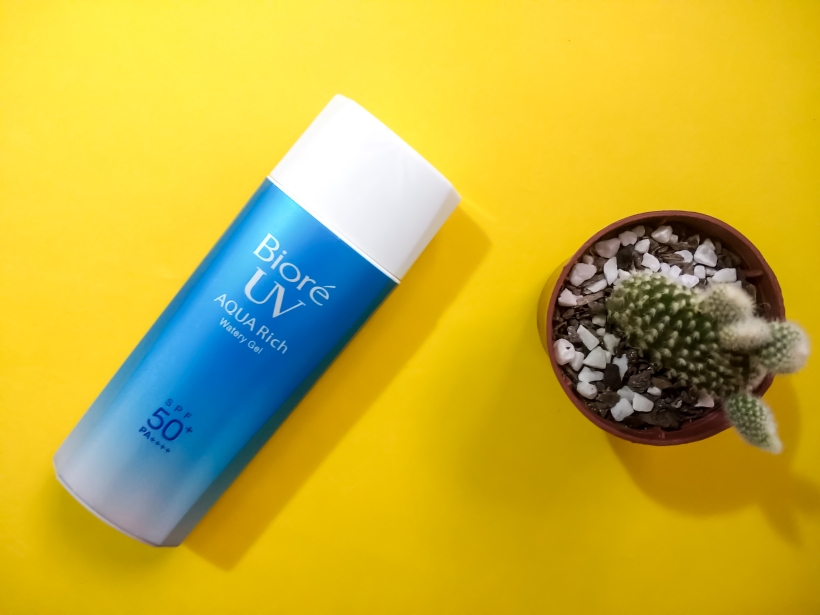
I will also provide a swatch of the two versions because I have still some left from the previous version.
Product description
Biore UV Aqua Rich Watery Gel is a daily use Japanese sunscreen gel that feels water-light.
The newly upgraded sunscreen gel is now resistant to water and sweat while having the sane weightless, water-gel texture and fresh finishing as its previous formula released in 2015. It features UV protection-enriched water capsules that turn the gel into a uniform, water-like protective veil when applied.
Added “light correction powder” gives the skin a light-diffusing effect for a fresh, brightened look. A blend of hyaluronic acid, royal jelly and “Mix Citrus Essence”* helps the skin retain moisture and softness.
The water-light gel provides durable protection against daily UV exposure without leaving a sticky or white residue. The skin feels fresh and bright. Best suited for everyday wear in the summer.
- For face and body;
- SPF 50+ PA ++++;
- Resistant to water and sweat (as confirmed in the water resistance test over 80 minutes);
- Double as a makeup base;
- Removable with face or body wash (no double-cleansing needed).
*Orange extract, grapefruit extract, lemon extract.
What is PA?
PA is used in Asian countries like South Korea and Japan. PA means Protection Grade of UVA. UVA rays penetrate the skin deeper than UVB rays and cause skin aging. Also, UVA is the predominant tanning ray.
According to the Japan Cosmetic Industry Association, PA+ corresponds to a UVA (PPD*) protection factor between 2 and 4, PA++ between 4 and 8, and PA+++ more than 8. This system was revised in 2013 to include PA++++ which corresponds to a PPD of 16 or higher.
A PA 10, for example, means it’ll take 10 times longer for your skin to tan.
*“The Persistent Pigment Darkening (PPD) is a method of measuring UVA protection, similar to the SPF method of measuring UVB light protection. It means that, theoretically, a sunscreen with a PPD value rating of 5 should permit tolerance of 5 times as much UVA as without protection.” (Source)
Ingredient list
Water, Alcohol, Ethylhexyl Methoxycinnamate, Lauryl Methacrylate/Sodium Methacrylate Crosspolymer, Titanium Dioxide, C12-15 Alkyl Benzoate, Bis-Ethylhexyloxyphenol Methoxyphenyl Triazine, Diethylamino Hydroxybenzoyl Hexyl Benzoate, Dimethicone, Ethylhexyl Triazone, Xylitol, Dextrin Palmitate, Hydrated Silica, Hydroxyethylcellulose, Glyceryl Stearate, Vinyl Dimethicone/Methicone Silsesquioxane Crosspolymer, Triethoxycaprylylsilane, Acrylates/C10-30 Alkyl Acrylate Crosspolymer, Cetyl Alcohol, C4-14 Perfluoroalkylethoxy Dimethicone, Aluminum Hydroxide, Potassium Hydroxide, Stearyl Alcohol, Stearic Acid, Agar, Polyvinyl Alcohol, Isoceteth-20, Sodium Methyl Stearoyl Taurate, Aminomethyl Propanol, Sodium Stearoxy PG-Hydroxyethylcellulose Sulfonate, Glutamic Acid, Ceratonia Siliqua (Carob) Gum, Maltose, Butylene Glycol, Propylene Glycol, Sodium Hyaluronate, Royal Jelly Extract, Citrus Aurantium Dulcis (Orange) Fruit Extract, Citrus Grandis (Grapefruit) Fruit Extract, Citrus Limon (Lemon) Fruit Extract, Phenoxyethanol, Disodium EDTA, BHT, Fragrance.
Analysis of some ingredients
Alcohol: Solvent;
Ethylhexyl Methoxycinnamate: Also called Octyl Methoxycinnamate, it is an active ingredient in OTC sunscreen products;
Lauryl Methacrylate/Sodium Methacrylate Crosspolymer: A film former and viscosity increasing agent that absorbs excess of oil in general;
Titanium Dioxide: Also known as Titanium White or Pigment White 6, it’s used as a whitening agent, sunscreen ingredient, coloring agent, thickening agent.
C12-15 Alkyl Benzoate: Mainly used as a thickening agent and emollient. It provides a light conditioning and silky touch and it’s been shown to act as a preservative and antimicrobial agent, particularly in sunscreen products;
Bis-Ethylhexyloxyphenol Methoxyphenyl Triazine: Known as Bemotrizinol, it’s an oil soluble compound. It is a broad spectrum UV absorber, absorbing UVB as well as UVA rays. Marketed as Tinosorb S by BASF and as Escalol S by Ashland Inc. Bemotrizinol is not approved by the United States FDA but is approved in the European Union since 2000 and other parts of the world.
Bemotrizinol has strong synergistic effects on the SPF when formulated with Bisoctrizole (Tinosorb M), Ethylhexyl Triazone (Uvinul T 150) or Iscotrizinol (Uvasorb HEB). It is the most effective UV absorber available measured by SPF, based on the maximum concentration permitted by European legislation. (Source);
Diethylamino Hydroxybenzoyl Hexyl Benzoate: Marketed as Uvinul A Plus by BASF, this ingredient is used in sunscreen to absorb UVA radiation. It has an excellent photostability (100%) and compatibility with other UV filters and cosmetic ingredients;
Dimethicone: It’s a silicone that works as an anti-foaming agent, skin and hair conditioner and skin protectant. It prevents transepidermal water loss (TEWL) by forming a hydrating barrier on the skin. It has a unique fluidity that makes it easily spreadable. It can also fill in fine lines/wrinkles on the face, giving it a temporary plump appearance;
Ethylhexyl Triazone: The most effective UVB filter. Marketed as Uvinul T 150, it is a white to light yellow powder that is not approved for use in OTC sunscreen products in the USA. It’s an ultraviolet absorber that is derived from triazine. It has high UV absorbency and due to it, only small concentrations are required to achieve a high SPF. It is completely insoluble in water, so it is often used in water-resistant formulas;
Xylitol: A sugar alcohol used as a humectant in cosmetics. It’s thought to help the skin retain moisture and increase levels of hyaluronic acid. It’s also thought to improve skin’s barrier function and increase ceramide synthesis;
Dextrin Palmitate: A palmitic acid ester of Dextrin. Works as anticaking agent, surfactant;
Hydroxyethylcellulose: A plant-derived amino acid used as a preservative, binder, emulsifier and/or thickener;
Glyceryl Stearate: Derived from palm kernel, vegetable or soy oil and also found naturally in the human body, it acts as a lubricant, which gives the skin a soft and smooth appearance. It slows the loss of water from the skin by forming a barrier on the surface. Also, it has been shown to protect skin from free-radical damage;
Vinyl Dimethicone/Methicone Silsesquioxane Crosspolymer: It’s a mix of silicone polymers that works as a thickening agent and texture enhancer;
Triethoxycaprylylsilane: Silicone-based ingredient used as a binder;
Acrylates/C10-30 Alkyl Acrylate Crosspolymer: Commonly found in moisturizers, sunscreens, cleansers and anti-aging products, it contains both hydrophobic and hydrophilic groups allowing it to bind to both water and oil, which makes it useful when combining two phases to create a single one. It is also used as a stabilizer, viscosity enhancer and also can form a film when applied topically;
Cetyl Alcohol: Please, do not get confused, this is not a drying alcohol. The truth is, this ingredient is the opposite of alcohol (ethanol) because it softens and conditions the skin and hair. It’s a fatty alcohol produced either from the end products of the petroleum industry or derived from plants. It works as an emollient, thickener, emulsifier and/or carrying agent;
C4-14 Perfluoroalkylethoxy Dimethicone: Skin conditioner, film former;
Aluminum Hydroxide: Acts as a skin protectant and opacifying (reduction of a clear/transparent appearance) agent in cosmetics. It’s used in an array of products including foundation, lipstick, and moisturizer. Many sunscreens use aluminum hydroxide as a coating for titanium dioxide – it prevents it from clumping and allows for an even application. Rather than penetrating the skin, it forms a refractive layer that helps reflect UV rays away from the skin. (Source);
Stearyl Alcohol: A naturally fatty alcohol derived from stearic acid, coconut oil or vegetable fatty acids. It’s used to soothe and soften the skin and also as an emulsifier;
Agar: A polysaccharide derived from seaweed, also known as Agar Agar. Mainly used as an emulsifier and thickening agent. Some people believe it has antioxidant properties because it comes from seaweed;
Polyvinyl Alcohol: Synthetic polymer of Viny Alcohol that works as a gel-based thickener, film former, and binder. It’s very used in peel-off facial masks;
Aminomethyl Propanol: pH adjuster;
Sodium Stearoxy PG-Hydroxyethylcellulose Sulfonate: It has water absorbing, film-forming, thickening, emulsifying abilities;
Glutamic Acid: An amino acid that works as pH adjuster, humectant;
Ceratonia siliqua (Carob) Gum: It has emollient effect, helps to stabilize the emulsion, forms a film on the skin and controls the viscosity;
Maltose: It’s a sugar that has humectant, moisturizing properties;
Butylene Glycol: Skin conditioning agent;
Propylene Glycol: Like other glycols and glycerols, it has hydrating and ingredient delivery properties;
Sodium Hyaluronate: The salt form of hyaluronic acid, a water-binding ingredient that has the ability to fill the spaces between collagen and elastin. Sodium hyaluronate has been used for moisturization and wound healing since its discovery, it can hold up to 1000 its own weight in water;
Royal Jelly Extract: It has moisturizing, skin healing and skin soothing effects. It can also inhibit melanin synthesis.
Topical royal jelly alleviates symptoms of pruritus in a murine model of allergic contact dermatitis;
Citrus aurantium dulcis (Orange) Fruit Extract, Citrus grandis (Grapefruit) Fruit Extract, and Citrus limon (Lemon) Fruit Extract: Named “Mix Citrus Essence”, it helps the skin to retain moisture and makes it soft;
Phenoxyethanol: Preservative;
Disodium EDTA: Preservative;
BHT (Butylated Hydroxytoluene): It’s a toluene-based ingredient used as a preservative in food and personal care products.
Acne triggers according to CosDNA
Dimethicone and Butylene Glycol strike 1 out of 5 while Cetyl Alcohol, Stearyl Alcohol, and Stearic Acid strike 2 out of 5.
Irritants according to CosDNA
Cetyl Alcohol and Stearyl Alcohol strike 2 out of 5.
Safety according to CosDNA
Most of the ingredients are green flagged (1 or 2 out of 9). Titanium Dioxide strikes 1 to 3 out of 9, while Potassium Hydroxide, Isoceteth-20, Aminomethyl Propanol, and Propylene Glycol strike 3 out of 9. Citrus grandis (Grapefruit) Fruit Extract, and Phenoxyethanol strike 4 out of 9. Ethylhexyl Methoxycinnamate and BHT strike 6 out of 9. Fragrance strikes 1 to 4 out of 9.
There isn’t a single red flagged ingredient.
CosDNA analysis: Bioré UV Aqua Gel 2017 Version.
Packaging
The packaging is gorgeous comparing with the last version. It has a beautiful shiny blue degradê color. It is big but not heavy.

It comes with 90 mL of product. The tube is soft and you don’t have to press it too hard to get the product out.
Texture and scent
As the product’s name says, the texture is like a watery gel. It’s very, very light and super moisturizing. It doesn’t leave any sign of stickiness.

The scent is very good, smells like an alcoholic grapefruit drink, I like it! The previous version doesn’t smell that good. It smells like Caipirinha (a Brazilian cocktail made with cachaça, sugar, and lemon) but it disappears when you apply it on your face.
How to use
Apply evenly over face, neck and/or body. Reapply as needed.
For you face, you need to apply at least 1.2mL (1/4 teaspoon) to achieve the SPF described on the label. The task of using 1.2mL is impossible when it comes to some sunscreens, but you don’t have to worry because this sunscreen is very light, making it very comfortable to be used.
UV Filters
Ethylhexyl Methoxycinnamate (aka Octyl Methoxycinnamate and Octinoxate), trade names Eusolex 2292 and Uvinul MC80:
- Range of UV spectrum covered: UVB;
- Wavelengths covered: 280-320 nm.
Titanium Dioxide:
- Range of UV spectrum covered: UVA (better covers UVA-2 than UVA-1), UVB;
- Wavelengths covered: good coverage between 290-350 nm; insufficient coverage between 350-400 nm, especially in microfine/nanoparticle forms.
Bis-Ethylhexyloxyphenol Methoxyphenyl Triazine (aka Bemotrizinol), trade name Tinosorb S:
- Range of UV spectrum covered: UVA (both UVA-1 and UVA-2), UVB;
- Wavelengths covered: about 280-400 nm, which covers both UVB and UVA ranges; peak protection at 348 nm.
Diethylamino Hydroxybenzoyl Hexyl Benzoate, trade name Uvinul A Plus:
- Range of UV spectrum covered: UVA;
- Wavelengths covered: maximum of 354 nm.
Ethylhexyl Triazone marketed as Uvinul T 150:
- Range of UV spectrum covered: UVB;
- Wavelengths covered: maximum of 314 nm.
Inorganic UV filters: Titanium Dioxide;
Organic UV filters: Uvinul MC80, Tinosorb S, Uvinul A Plus, and Uvinul T 150.
Performance
As said before, this sunscreen is very light. You can easily use the right amount of it to achieve the right SPF. It is not white-cast free but it’s almost there. I don’t feel like it leaves me like a ghost, I even like the finishing it leaves under my eyes, making it whiter and smoother.
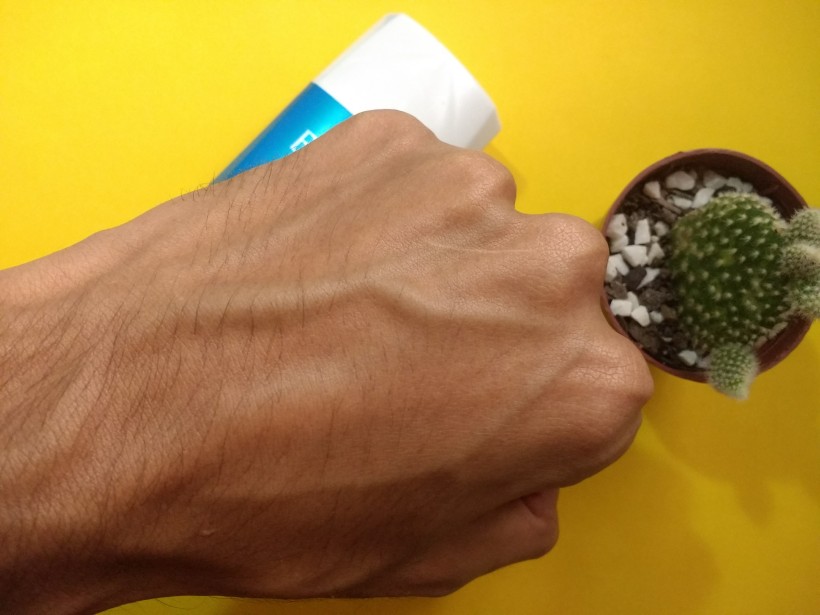
Bare hand.

The amount of sunscreen used.
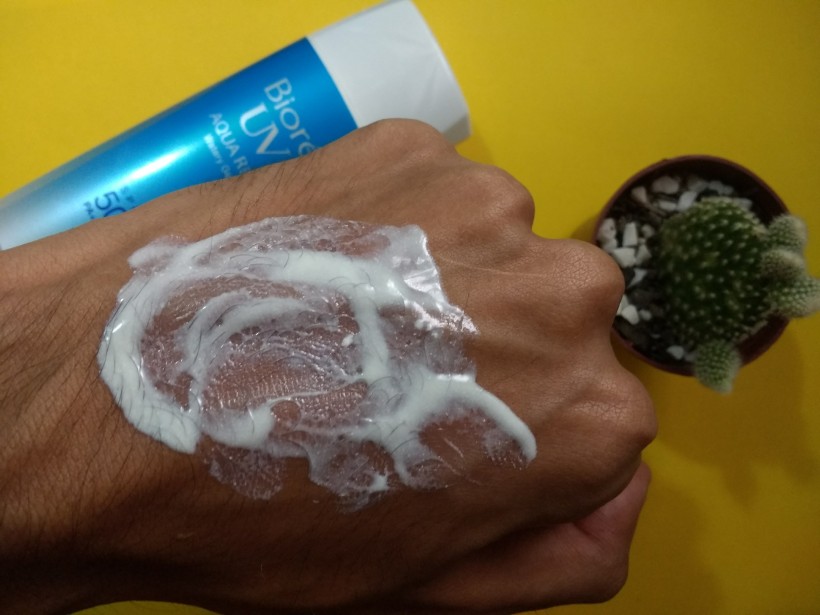
Spreading it… You can see many capsules.
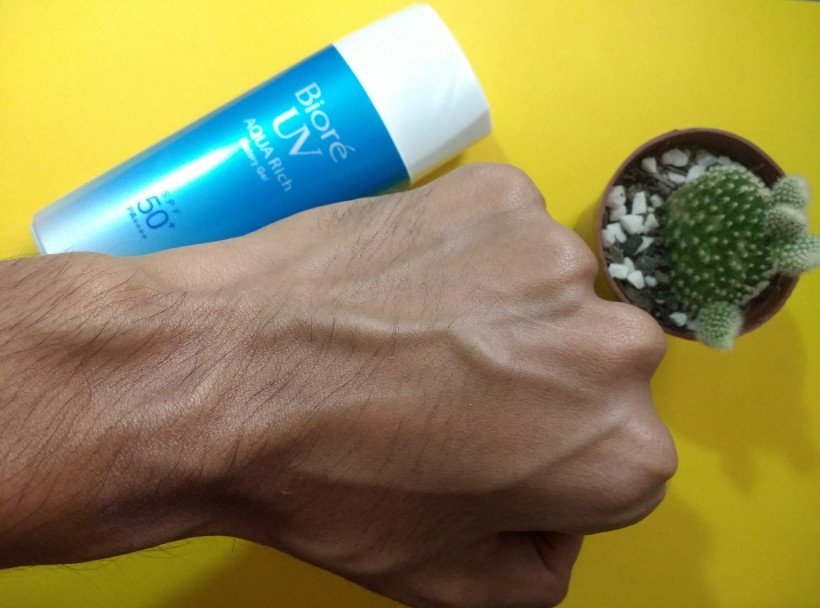
Above you can see its finishing. I really like it. It leaves a bit of glow, so when it’s too hot outside, I always use a transparent setting powder to minimize the glow. It also leaves my face super moisturized and soft. The finishing is very powdery.
Comparison
I was saving this version (2015) of the Bioré Aqua Gel because it could be handy to make a comparison with the new version (2017). The old version smells like Caipirinha.
Below you can see the pictures.
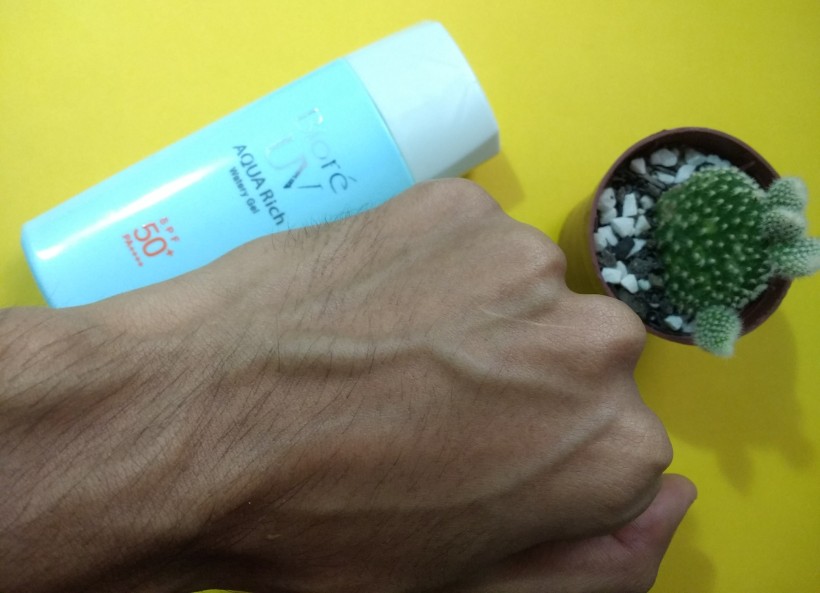
This is my bare hand after washing it.
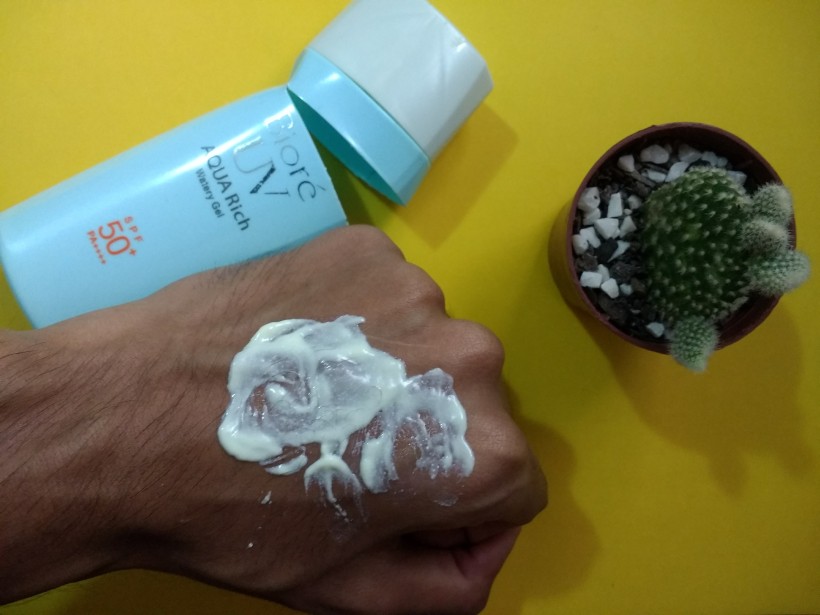
The texture and amount of the product I’ve used. I think I’ve used too much, but it’s ok.
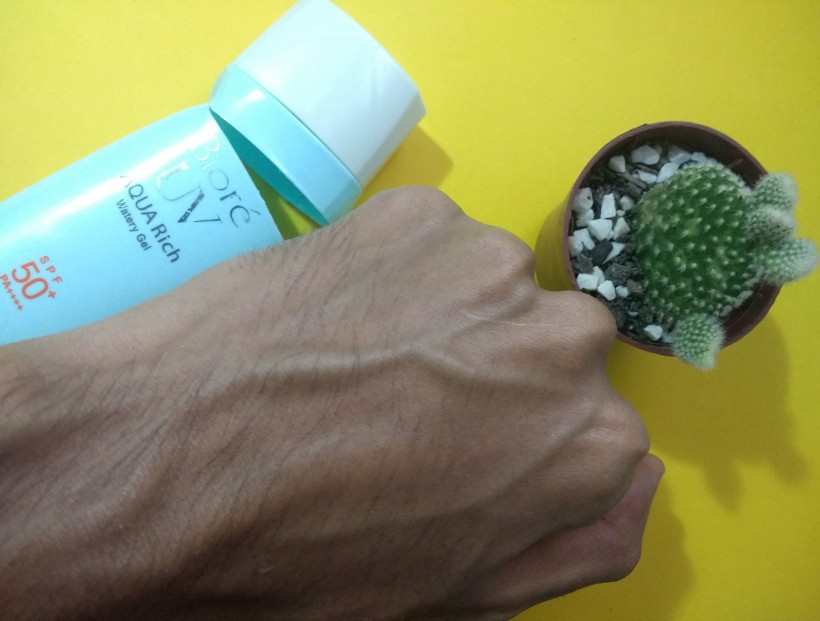
The finishing.
I feel like this old version doesn’t leave as much white as the new one does. I feel like it has a lower amount of Titanium Dioxide comparing with the 2017 version. Checking the ingredient list of the 2017 version, Titanium Dioxide comes in 5th place while the 2015 version has Titanium Dioxide as the 11th ingredient (the less concentrated UV filter of 2015’s version). Also, this old version takes longer to dry. Bellow, you can see more of the finishing of 2015’s version.
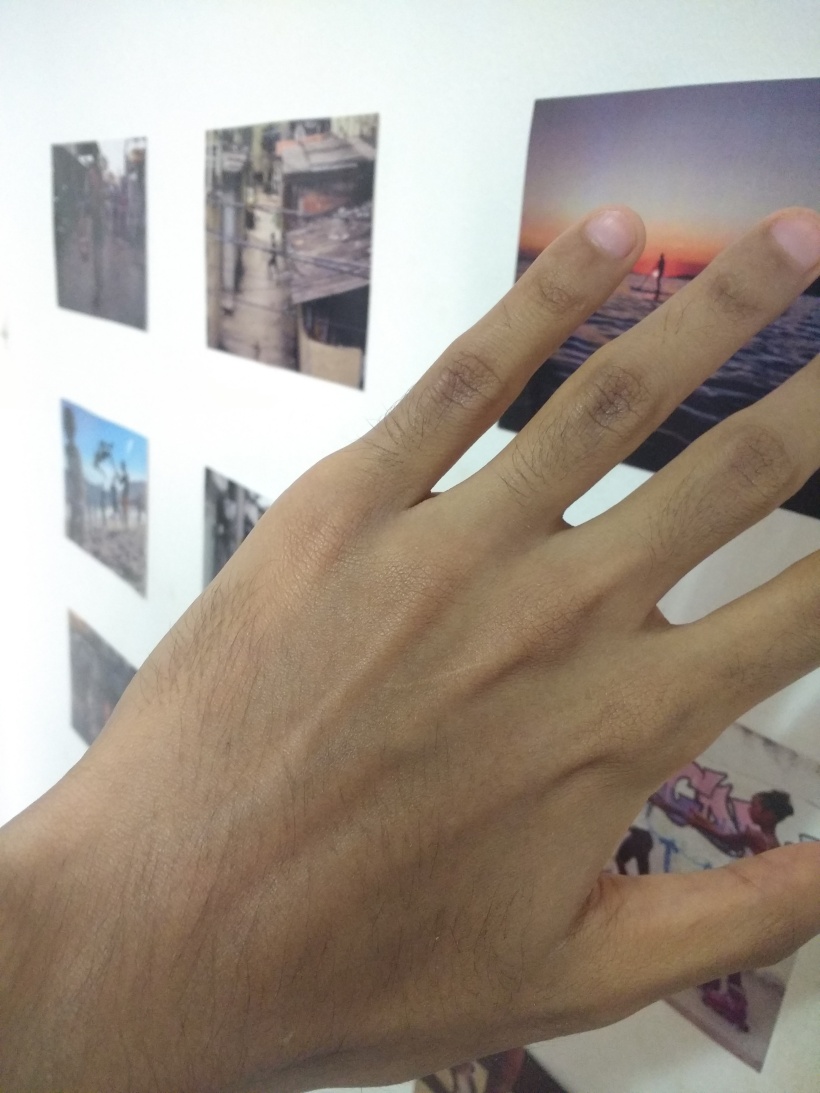
It’s almost 100% transparent even though I think I applied too much. I would say it’s 95% of transparency.
Bellow, you can see the finishing of 2017’s version.

Do you see the difference? The 2017 version indeed has a stronger white cast.
Final thoughts
I will first share my final thoughts about the 2015 version and then about the 2017 version.
The 2015 version isn’t water/sweat resistant. It is more transparent on the skin than the new version and also seems to have less alcohol. It doesn’t make my skin dry, it moisturizes it instead.
I found that the 2017 version has a higher white cast than the 2015 version. It dries out much quickly because it seems to have also a higher amount of alcohol. Even though it has alcohol as the second ingredient, I haven’t experienced any dryness caused by this sunscreen, on the contrary, it moisturizes my skin very well.
It is very light, leaves a healthy glow and a soft and hydrated skin. It doesn’t control oil and doesn’t have a matte finishing but it doesn’t leave any greasy feeling. It is easily removed with only face/body wash.
Bioré UV Aqua Rich Watery Gel (whatever version it is) is a sunscreen made to be used on the body and/or face, that’s why it’s bigger than the other Bioré sunscreens.
I give both the same rate because both have some issues: 2015 version isn’t water/sweat resistant, while 2017 is. 2017 leaves a stronger white cast (on me) when compared with the 2015 version. The white cast on me is minimal, don’t worry if you are lighter than me because I hardly believe that you will spot any whiteness.
Both are amazing sunscreen and I recommend them. They are great for skins that don’t need oil control ability. I feel that both versions have a similar powdery finishing but the new version dries much quicker.
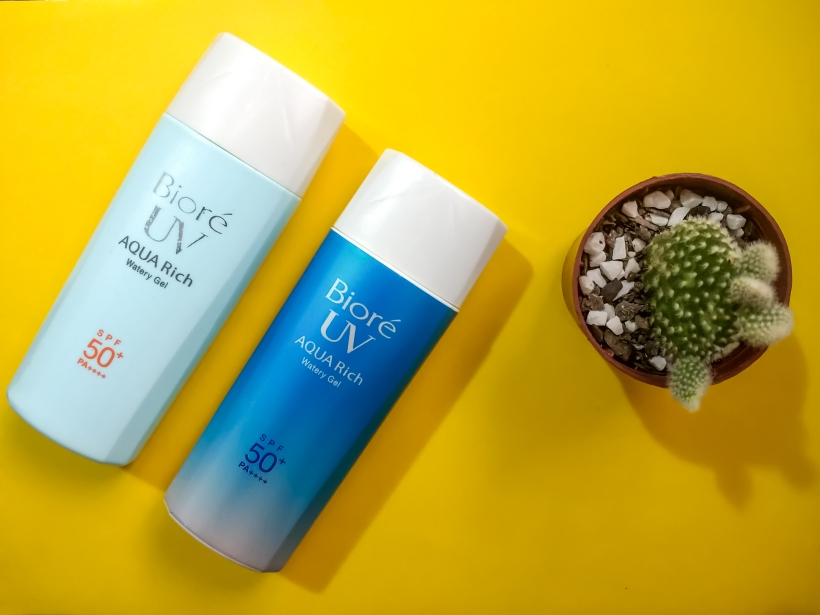
If I had to stick to one version, I would stick to 2017’s because it’s water/sweat resistant.
Rate 2015 Version: 4.5/5
Rate 2017 Version: 4.5/5
Thanks for the thorough review. I’ve only tried the old version but never noticed it smelling like caipirinha! 😋 Sounds delicious. -Angela
LikeLiked by 1 person
Thanks!
I feel like it smells caipirinha. hahaha
New version smells better.
LikeLike
The 2015 version is kind of my HG and I can’t wait until the 2017 is release here in the Philippines.
LikeLiked by 1 person
I hope you enjoy it!
LikeLike
Nice review….thoroughly researched and answered a lot of my queries….
LikeLiked by 1 person
Thanks. 🙂
LikeLike
hate the new 2017 version. the white cast is WAY too noticible honestly 😦
can you recommend me a elegant no white cast sunscreen that is cheap and has VERy good UVA protection. I was in europe on holiday and managed to get the la roche posay nutritive which does all this plus no white cast (its an oil) and PPD of 35. I can’t buy anymore since im not europe anymore 😦
LikeLiked by 1 person
The only product with high PPD that I’ve used was Bioré Aqua Gel (PA++++). I like Nivea Super Aqua Gel but it has PA+++.
LikeLike